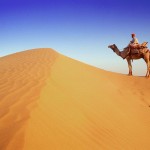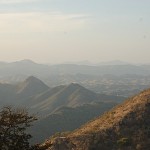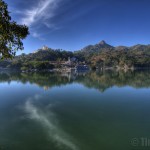 Wish to experience the splendour of rustic Indian culture? Want a piece of the Indus Valley Civilization? Or perhaps witness the chaos at a cattle fest? Then Rajasthan is the place to be. Established on 1st November, 1956, this state has been rightly called as ‘Land of Kings’. The palaces, monuments and culture of the state attract tourists from all over the world. However, the vast and varied geography of the state is often overlooked. From the endless sea of sand called Thar to jungles of Ranthambhore to hills of Mt. Abu, Rajasthan has a lot to offer to the traveller:
Wish to experience the splendour of rustic Indian culture? Want a piece of the Indus Valley Civilization? Or perhaps witness the chaos at a cattle fest? Then Rajasthan is the place to be. Established on 1st November, 1956, this state has been rightly called as ‘Land of Kings’. The palaces, monuments and culture of the state attract tourists from all over the world. However, the vast and varied geography of the state is often overlooked. From the endless sea of sand called Thar to jungles of Ranthambhore to hills of Mt. Abu, Rajasthan has a lot to offer to the traveller:
Page Contents
The largest Indian state:
Covering an area of 342,239 km2, Rajasthan accounts for 10.2% of the total Indian land. Rajasthan shares its western and north-western borders with neighboring Pakistan. Punjab, Uttar Pradesh and Haryana are to the north and north- east of the state. Madhya Pradesh is to the south-east and Gujarat to the south-west of this regal state.
 Varied topography:
Varied topography:
The oldest mountain ranges of India – the Aravalli ranges – are in Rajasthan, as is the largest desert in India, Thar, which covers almost 70% of the state. Only 9.36% of the land is under vegetation. The plateau regions of Malwa and the fertile plains of Mewar also form an important part of Rajasthan’s topography.
The Great Indian Desert:
Thar requires a special mention as it forms a very important part of the state’s geography. The desert receives a meager 25cm annual rainfall as a result of which the only vegetation found here are shrubs, thorny bushes and other plants that can adapt to a very hot and dry climate. Temperatures in the desert are extreme with days being very hot and the nights very cold.
Different seasons, different climates:
Summers in Rajasthan extend from April to June with the temperatures ranging from 32°- 46°C. July to September is the monsoon season bringing respite from the summer heat. The post monsoon months of October and November have an average temperature of 35°C. In general, the temperatures vary from 4°C to 28°C during the winter months of December to March. Mercury drops below 0°C in the state’s only hill station, Mt. Abu.
Soil and Vegetation:
The western desert districts have alkaline and saline soils with a calcareous base. The plateaus and the Aravalli ranges consist of dark lava soil which is good for the growing cotton and sugarcane. The plains flooded by the Ghambhiri and Banganga rivers are a storehouse for alluvial, clay and loamy soil.
 Flora and Fauna:
Flora and Fauna:
Due to Rajasthan’s inherent geographical vastness, many different plants and animals have found home here. The Desert National Park located in Jaisalmer, is a brilliant example of the ecosystem of Thar Desert. Various migratory birds like flamingos, the Siberian crane, common teal, black tailed-Godwit and wood sandpiper have found refuge in the state’s Mansagar Lake. Ranthambore National Park is the place to visit if you want to enjoy a stroll with tigers, gazelles, foxes or blackbucks.
This kaleidoscope of weathers, landmasses, flora and fauna make Rajasthan an ideal place to spend some quality time with your friends and family and create memories.

Facebook comments: ManaHotels